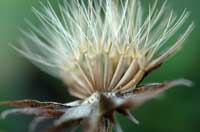A Journey Through the Scott Creek Watershed

 Headlands
Headlands
The headlands, with their melange of scarce and ubiquitous grasses—leafy bent grass (Agrostis pallens),
 maritime brome (Bromus maritimus), California hair grass (Deschampsia cespitosa subsp. holciformis), wild rye (Elymus glaucus subsp.
virescens), California fescue (Festuca californica), June grass (Koeleria macrantha), Torrey's melic (Melica torreyana), and
San Francisco bluegrass (Poa unilateralis subsp. unilateralis); hidden pockets of coarse-leaved San Francisco wallflowers
(Erysimum franciscanum), with highly fragrant gold flowers meriting horticultural use; chameleon-like Bolander's golden aster
(Heterotheca sessiliflora subsp. bolanderi), with herbage variable both as to coloration and scent; one of the ancestors of
maritime brome (Bromus maritimus), California hair grass (Deschampsia cespitosa subsp. holciformis), wild rye (Elymus glaucus subsp.
virescens), California fescue (Festuca californica), June grass (Koeleria macrantha), Torrey's melic (Melica torreyana), and
San Francisco bluegrass (Poa unilateralis subsp. unilateralis); hidden pockets of coarse-leaved San Francisco wallflowers
(Erysimum franciscanum), with highly fragrant gold flowers meriting horticultural use; chameleon-like Bolander's golden aster
(Heterotheca sessiliflora subsp. bolanderi), with herbage variable both as to coloration and scent; one of the ancestors of
 our modern strawberry, beach strawberry (Fragaria chiloensis), forming mats of interweaving red stolons contrasting with the
durable leathery leaflets; rattlesnake carrot (Daucus pusillus), native sister species to the domestic carrot, with foliage and
compound umbels so finely dissected that magnification is needed to fully appreciate the structural details; purple-suffused California broomrape
(Orobanche californica subsp. californica), an uncommon taxon parasitizing Grindelia species; and western dock
(Rumex occidentalis), a visually arresting plant reaching four to six feet in height, with mature stems and inflorescences
pigmented a luminous reddish-pink.
our modern strawberry, beach strawberry (Fragaria chiloensis), forming mats of interweaving red stolons contrasting with the
durable leathery leaflets; rattlesnake carrot (Daucus pusillus), native sister species to the domestic carrot, with foliage and
compound umbels so finely dissected that magnification is needed to fully appreciate the structural details; purple-suffused California broomrape
(Orobanche californica subsp. californica), an uncommon taxon parasitizing Grindelia species; and western dock
(Rumex occidentalis), a visually arresting plant reaching four to six feet in height, with mature stems and inflorescences
pigmented a luminous reddish-pink.
In spite of human activity, encompassing both vehicular and foot traffic, numerous micro-habitats featuring concentrated
species diversity can still be found within this unique
 environment where earth,
sky, and water meet! A small drainage depression perched high on the bluffs overlooking Greyhound Rock and no more than 10 meters square is home to Blasdale's
bent grass (Agrostis blasdalei), one of California's rarest grasses, and Michael's rein orchid (Piperia michaelii), an orchid of
uncommon occurrence. Ironically, two more frequently encountered relatives of the aforementioned taxa also occur within this "pocket of biodiversity," namely
California bent grass (Agrostis densiflora) and coast rein orchid (Piperia elegans subsp. elegans). This juxtaposing of rare and common
members of the same genus is found throughout the
environment where earth,
sky, and water meet! A small drainage depression perched high on the bluffs overlooking Greyhound Rock and no more than 10 meters square is home to Blasdale's
bent grass (Agrostis blasdalei), one of California's rarest grasses, and Michael's rein orchid (Piperia michaelii), an orchid of
uncommon occurrence. Ironically, two more frequently encountered relatives of the aforementioned taxa also occur within this "pocket of biodiversity," namely
California bent grass (Agrostis densiflora) and coast rein orchid (Piperia elegans subsp. elegans). This juxtaposing of rare and common
members of the same genus is found throughout the
 Scott Creek Watershed. Nestled cheek-to-jowl in this same niche are one-leaved onion (Allium unifolium), a descriptive name at odds with this species'
actual foliar status; Choris's popcorn-flower (Plagiobothrys chorisianus var. chorisianus), often hidden within the undergrowth; harlequin lotus (Hosackia gracilis),
Scott Creek Watershed. Nestled cheek-to-jowl in this same niche are one-leaved onion (Allium unifolium), a descriptive name at odds with this species'
actual foliar status; Choris's popcorn-flower (Plagiobothrys chorisianus var. chorisianus), often hidden within the undergrowth; harlequin lotus (Hosackia gracilis),
 a perennial pea with flowers yellow and cerise possessing a fragrance rivaling the best French perfumes; California canary
grass (Phalaris californica), with leaves and stems mimicking the stylized bamboo of the classic Chinese landscapes; sticky
sand-spurrey (Spergularia macrotheca var.
macrotheca), an ideal candidate for miniature rock gardens; Mexican plantain (Plantago subnuda),
a visually arresting species with conspicuously ribbed leaves contrasting with the densely flowered scapes; and marsh microseris (Microseris paludosa),
a rarely seen relative of the dandelion and culinary lettuce.
a perennial pea with flowers yellow and cerise possessing a fragrance rivaling the best French perfumes; California canary
grass (Phalaris californica), with leaves and stems mimicking the stylized bamboo of the classic Chinese landscapes; sticky
sand-spurrey (Spergularia macrotheca var.
macrotheca), an ideal candidate for miniature rock gardens; Mexican plantain (Plantago subnuda),
a visually arresting species with conspicuously ribbed leaves contrasting with the densely flowered scapes; and marsh microseris (Microseris paludosa),
a rarely seen relative of the dandelion and culinary lettuce.
All photographs © Dylan Neubauer